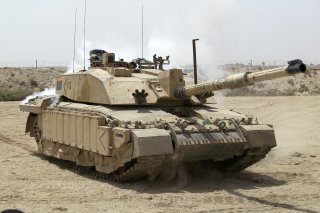British Army Is Planning to Upgrade Just 148 of Its 227 Challenger 2 Tanks
A problem?
The British Army is planning to upgrade just 148 of its 227 Challenger 2 tanks, according to The Times.
The proposed cut to the armored force -- the British Army’s second major reduction in tanks since 2010 -- would make the U.K. ground-combat branch the 56th biggest tank-operator, The Times estimated.
Cutting tanks could jeopardize London’s plan to revamp its armed forces for high-tech combat with a major world power such as Russia.
As recently as 2010 the British Army possessed 316 of the 408 Challenger 2 tanks it originally acquired starting in the late 1990s.
Deep cuts across the U.K. armed forces in 2010 eliminated not only 89 tanks, but also two aircraft carriers, two amphibious ships, four frigates, an army brigade, a third of the army’s artillery and all of the air force's Harrier jump jets and maritime patrol planes. Uniformed manpower dropped by 30,000.
As recently as late 2017, there were rumors that the United Kingdom might try to offset the cost of the country's exit from the European Union by further cutting the military. Army brigades and amphibious ships appeared to be particularly vulnerable.
Instead, funding stabilized at around $55 billion annually. In 2017 and 2018, the government allocated the armed forces an extra $2 billion, combined, above planned spending levels, enough to employ 196,000 active and reserve sailors, soldiers, airmen and civilian personnel.
The modest spending boost gave planners some hope that budgetary shortfalls -- a perennial problem for the U.K. armed forces -- finally were coming to an end. Around the same time, London proposed to reconfigure its military for major conflict.
"After almost three decades of relative international stability, the world has now re-entered a period of persistent and intense state competition," the U.K. Defense Ministry stated in its December 2018 review "Mobilizing, Modernizing & Transforming Defense."
To deter and defeat potential enemies, the study asserted, the British military should be able to deploy a 50,000-person task force including a maritime task group centered on a Queen Elizabeth-class aircraft carrier embarking F-35 stealth fighters, an army division with three brigades, an air force group with combat, transport and surveillance aircraft and a special forces task group.
Banking on the higher level of spending to continue, officials plan on building and maintaining a fleet including two Queen Elizabeth-class carriers, six Type 26 destroyers, eight Type 26 frigates, five low-cost Type 31 frigates, seven Astute-class attack submarine, 24 patrol vessels, 12 minehunters, five amphibious assault ships and nine logistics ships, together embarking six helicopter squadrons and 48 F-35 stealth fighters.
The air force would possess at least 20 Reaper-style armed drones, seven squadrons of Typhoon fighters each with around a dozen planes and two squadrons of F-35s plus 26 patrol, surveillance and command planes, 44 cargo planes and 14 tankers.
The army would have two tank brigades, two mechanized brigades, six infantry brigades, a parachute brigade and 15 helicopter and drone squadrons, each with around 15 aircraft. If the cuts The Times reported take effect, the two tank brigades would share just 148 tanks.
The U.S. Army’s own tank brigades are much larger with around 90 M-1 tanks apiece.
The Challenger 2s have suffered from a lack of upgrades. A new urban camouflage scheme that the Royal Tank Regiment in 2017 applied to a few Challenger 2s belied the vehicles’ unupgraded guns, armor and engines.
The Ministry of Defense in 2019 could award a contract for the Challenger 2’s first major update in years. “Rheinmetall has offered to swap the Challenger’s 120-millimeter rifled gun for a smoothbore weapon, while the BAE-led partnership Team Challenger 2 offered to fit an active protection system,” Defense News reported.
“The army would probably like both, but given the dire state of the defense budget, affording even one of those options is problematic,” Defense News added.
The army would use the 79 tanks it retires as a source of spare parts, The Times reported. “It is possible that some could be patched up for deployment in an emergency.”
David Axe serves as Defense Editor of the National Interest. He is the author of the graphic novels War Fix, War Is Boring and Machete Squad.

